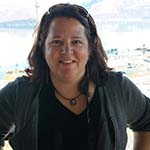By Betsi Oliver
Outreach Coordinator
In September, Council volunteers brought a message of citizen engagement and oil spill prevention to Kenai’s second and third graders.
At the education event known as Masters of Disaster, students engaged in engineering challenges, learned principles of chemistry, got an introduction to tanker design, and practiced oiled wildlife response. The principal of Kenai’s Mountain View Elementary, Karl Kircher, says that making connections at this young age to career pathways, engineering, and applied sciences is crucial, because students are deciding whether school is meaningful for them and what their future might hold.

The community showed their support. Parents texted teachers saying that the activities gave their children meaningful points of connection with their own Exxon Valdez oil spill cleanup efforts. The Peninsula Clarion ran a front-page photo titled “Getting their hands dirty for science.”
Ten volunteers spent two hours non-stop with groups of students: Board members Patience Andersen Faulkner, Mike Bender, and Dorothy Moore; committee chairs Jane Eisemann, Jim Herbert, John Kennish, and Steve Lewis; committee members Cathy Hart and Savannah Lewis; and a guest volunteer, Deb Hart. Amanda Johnson, Betsi Oliver, and Nelli Vanderburg of staff completed the team.

In one station, students used a variety of materials to represent boom, skimmers, and other cleanup materials to keep oil off a model beach. Another station showed the impact of weatherization on oil, how a small drop can spread into a large layer of sheen that is hard to contain or be whipped up into mousse that is hard to remove. Investigating ship design was a blast when students ran the length of the Exxon Valdez – 987 feet – and got to handle a Lego version of a double-hulled tanker. At the wildlife response station, students investigated what happens to oiled eggs (answer: oil can absorb through the shell) and experimented with different cleaners to remove oil from feathers. Even using the same product that professional responders use to clean oiled animals, the students saw firsthand that the oil could not be completely washed away. That highlighted the message of the day: Cleaning up spilled oil is tough. Prevention is the best and only way to keep the environment free from oil.
In the past, this program has been offered in smaller schools. It was the first time we offered Masters of Disaster to a community the size of Kenai. The Council regularly adapts its education, and outreach, efforts to best suit the needs of our diverse communities. Next fall we’ll take Masters of Disaster on the road again to Seward. Hope to see you there!
Three Council-related reports accepted at conferences this year
- “Exxon Valdez Oil Spill and the Prince William Sound Long Term Environmental Monitoring Program” by long-time contractor Jim Payne will be presented at the 2020 International Oil Spill Conference. This Council program has gathered data on the presence of hydrocarbons in sediments and mussels in the region since 1993.
- “Providing a local voice for setting priorities in Alaska for human health, and social and economic disruptions from spills” by Davin Holen, member of the Council’s Scientific Advisory Committee, will be presented at the 2020 International Oil Spill Conference.
- “Alaska’s Oil Spill Response Planning Standard – History and Legislative Intent” by Elise DeCola and Tim Robertson, authors of the Council-sponsored report of the same name, was presented at the 2019 Alaska Historical Society Annual Conference.

